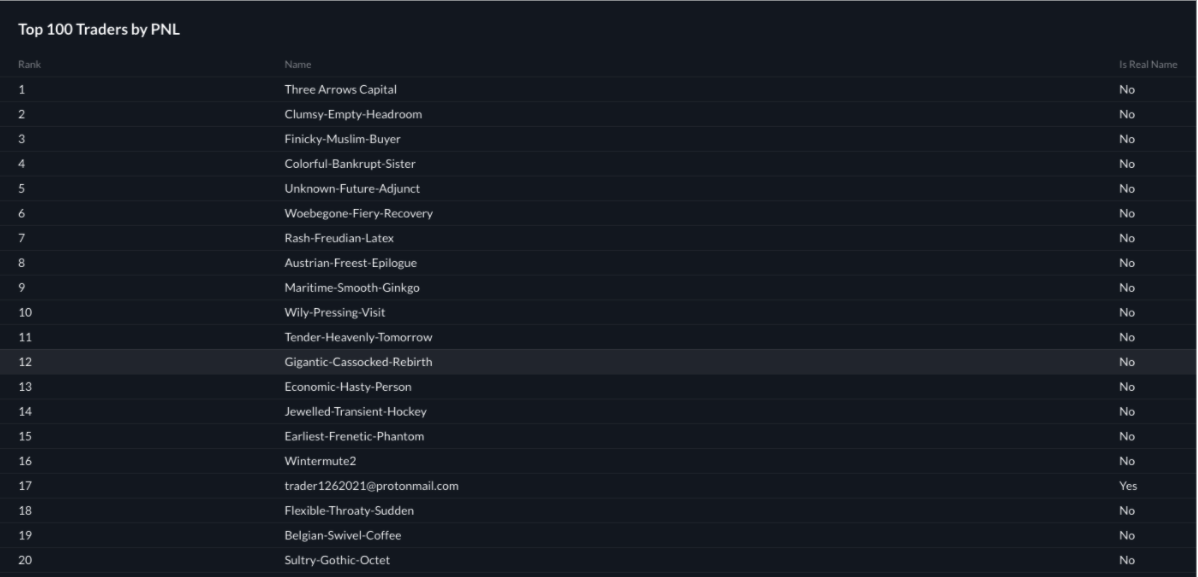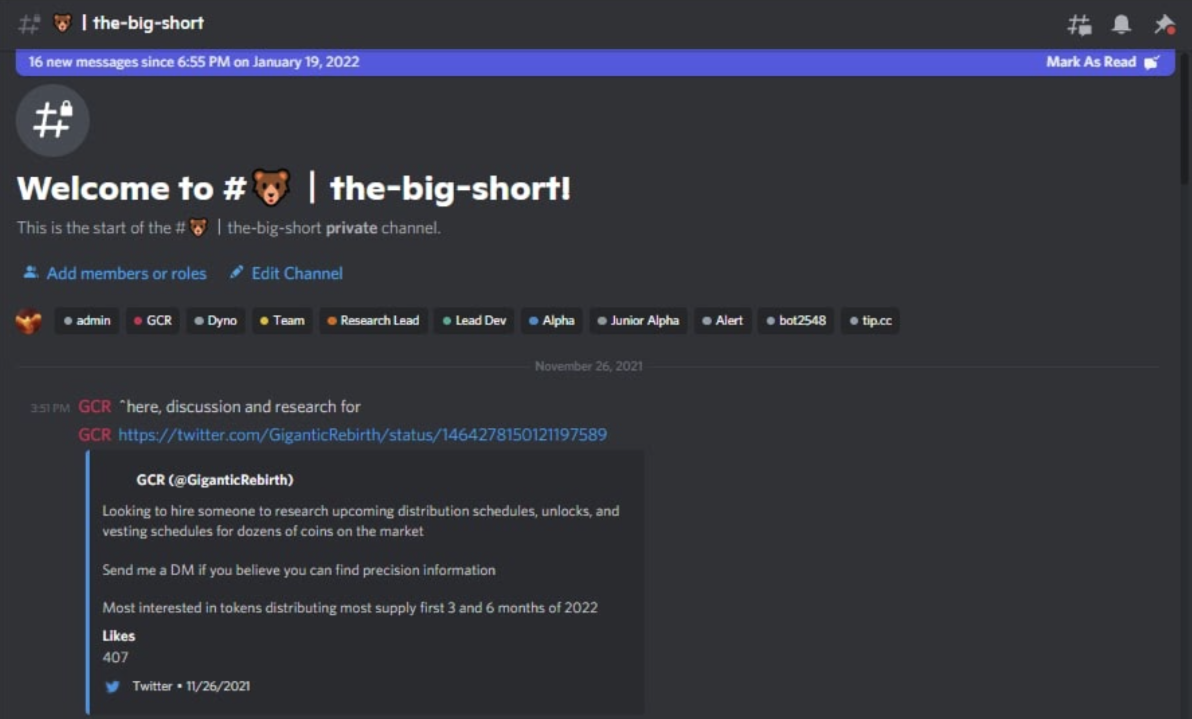
How the 'Big Short DAO' Bet Against the Crypto Market and Won
In late November, a pseudonymous crypto trader behind the Twitter handle @GiganticRebirth issued a warning to his legion of over 85,000 followers.
“High confidence interval that we're very late in the cycle [and that cycles still exist],” he wrote. “Secure your freedom if you've won it.”
@GiganticRebirth, who also goes by GCR (an acronym for Gigantic-Cassocked-Rebirth), said he was feeling increasingly bearish about the cryptocurrency market, which had just enjoyed a 20-month-long bull run that showed no signs of stopping.
As others shilled predictions of “a new crypto supercycle” or “bitcoin to $100K,” GCR was planning a different, contrarian trade: a big short, or a major bet against overvalued altcoins that would generate massive profits if his bearish views played out.
To pull off the trade, he says he assembled a smattering of part-time crypto researchers, ranging from a professional poker champion to a medical student. They shared their findings with each other in a Discord channel and traded on their own.
GCR says he shorted nearly 30 different tokens across multiple exchanges at the height of crypto fervor last November. In January, he tweeted out a screenshot of a trading dashboard from the FTX crypto exchange, purportedly showing big profits from the gambit.
And without quite wanting to reveal his true identity, he now wants to tell his story.
“The market consensus is that no one saw this coming,” GCR told CoinDesk in a phone call. “I saw it coming, I took action."
Over the past 13 years, the crypto industry has minted billionaires who were early to bitcoin and held onto the asset as its price mounted a seemingly inexorable climb.
But in the notoriously volatile world of cryptocurrencies, timing these rapid market cycles has proved far trickier. In fact, there's no telling whether profitable trades can be replicated in the future.
The crash that started in late 2021 and extended through January sent the total crypto market capitalization plummeting from a high of $3.1 trillion in November to $1.7 trillion in late January, nearly wiping out half of its value. Breaking even during a market downturn is difficult; profiting is even harder.
GCR's tale offers also a window into the quirky world of crypto markets, where individual traders sometimes team up to speculate on volatile asset prices, hoping their collective assessment proves right.
To corroborate the key elements of GCR’s story, a CoinDesk reporter talked to him and several of his collaborators via phone calls, Telegram messages and Discord chats. Nearly all of them declined to provide their real names, asking to be identified only by their pseudonymous Twitter and Discord handles. However, GCR has a reputation, as evidenced by the high five-figure following he has built on Twitter in the past year. He also regularly appears – under the moniker Gigantic-Cassocked-Rebirth – on the FTX exchange’s Top 100 Traders leaderboard, which ranks users by profit and loss. (Currently he’s No. 12).
With faint echoes of “The Big Short,” Michael Lewis’ book (adapted into a hit movie) about Wall Street misfits who bet against the frothy U.S. housing market, here is the story of how one independent crypto trader appears to have predicted last year's market top, collaborating with a ragtag team of alpha hunters.
The Bitcoin ETF trade
It all started in October, when a group of crypto traders assembled in a Discord chat to focus on one of the biggest market catalysts of the year: whether the U.S. Securities and Exchange Commission (SEC) would grant approval for a hotly anticipated bitcoin futures exchange-traded fund (ETF).
If the group could spot and digest the decision minutes, even seconds, before the rest of the market, they might be able to profit off a move in bitcoin’s price.
To prepare, the team of pseudonymous collaborators – they didn't share their real names with each other on Discord – spent days researching arcane regulatory filings and coding web-scraping bots.
On Oct. 15, 2021, at 4:15 p.m. ET, a web-scraping bot pinged the Discord group as soon as an announcement went up: A new SEC filing had just been posted regarding the Proshares Bitcoin ETF.
The news: approved (or technically, not opposed). The bot notification gave the group enough time to buy bitcoin before much of the world had time to process the bullish news. The price of bitcoin instantly popped to about $59,000 from $57,100.

The price of bitcoin instantly popped to $59,000 from $57,100 upon news of the ETF approval. (Messari)
A ‘decentralized’ hedge fund
The team behind the ETF experiment called itself RebirthDAO, a "decentralized autonomous organization" founded by GCR.
In most blockchain-related conversations, a DAO is a decentralized organization powered by a token that confers voting rights; this was really just an informal group that met in a Discord channel.
“The idea was to form a decentralized hedge fund,” GCR told CoinDesk in one of a series of phone calls and Telegram exchanges. “A space where people could get together and look for alpha.”
Alpha refers to the excess returns that some investors seek to pocket above and beyond typical market returns, known as beta. The pursuit often relies on bespoke strategies; in both crypto and traditional financial markets, alpha is difficult to achieve and trading secrets are closely guarded.
“GCR had told me early on that DAOs were going to change the industry,” Discord user fungible0x, a member of the group who acts as liaison between GCR and the moderators, told CoinDesk in a Discord call. “From the beginning, he knew there were many smart minds to collaborate with in crypto. He saw a vacuum for that kind of space.”
Forecaster
GCR, the driving leader behind RebirthDAO, regularly ranks high on a closely watched list known as the FTX Top 100 Traders by PNL or “FTX Leaderboard.”
The moniker, he says, was a randomly generated username from FTX that he has stuck with throughout the years.
To prove he was the same trader as shown on the FTX Leaderboard, GCR briefly changed his display name there to a Gmail address, and then communicated with CoinDesk via email with that account.
The leaderboard is not only a scorekeeper for the FTX exchange’s 100 most profitable trading accounts, but also doubles as a who’s who of the crypto industry’s top traders; making the cut is considered an impressive feat. Other highly ranked traders include Three Arrows Capital, seen as an industry heavyweight.

FTX Leaderboard for Feb. 15, 2022. (FTX)
Since mid-2020, GCR has amassed a cultish legion of over 85,000 Twitter followers. The account has attracted speculative retail “copy-traders” who trade according to his recommendations.
His tweets have ranged from theses on shorting frothy metaverse tokens to calling the SHIB run and other dog-coin phenomena.
Before crypto, GCR says he cut his teeth trading political prediction markets on the popular betting site PredictIt.
In addition to his market calls, his political tweets have ranged from correctly predicting the retirement of Supreme Court Justice Stephen Breyer to betting on the underdog run of French Presidential candidate Valérie Pécresse.
Since switching over to crypto, GCR’s contrarian market calls have earned him recognition from Three Arrows Capital's Su Zhu.
“For 3 1/2 years, I did not take a single day off,” said GCR when asked about his trading background. “You have to sacrifice literally everything.”
“He’s a benevolent assassin,” RebirthDAO member and Discord user Pxeo said of GCR in a phone call with CoinDesk. “He’s very good at cutting through things to get to the truth of the situation. There are no better market sentiment accounts on Twitter.”
Frothy signs
On Nov. 22 - just 12 days after bitcoin peaked around $69,000 but at a time when some commentators were still calling for a $100,000 price by year-end - GCR tweeted out his most controversial prediction yet.
He was “back and shorting” the market, just as bitcoin and Ethereum's ether notched new all-time highs and some crypto traders crowed that a "supercycle" might carry prices even higher.
“You just had every froth indicator. The total market cap of all crypto in November was at its peak, over $3 trillion,” said GCR. “There was peak euphoria and belief in eternal cycles. It was really contrarian at the time.”
In addition to perceiving a gloomy macro climate, GCR also had strong conviction in seasonality. In 2017, just before the last prolonged bear market, bitcoin and other cryptocurrencies had begun falling in December; by early 2018, it was a full-blown meltdown.
To GCR, the signs pointed to an obvious new trade: short the market.
He believed the best way to profit off of the inevitable sell-off would be to bet against overbought altcoins, which stood to lose up to 90% of their value in a bear market.
“We knew that the Fed was going to signal a more hawkish stance,” said GCR. (A more aggressive approach by the Fed to tame inflation would undermine the “digital gold” case for bitcoin and/or spur selling by investors who viewed the cryptocurrency as a risk asset. And where bitcoin goes, the rest of crypto follows.)
“Everyone had been saying for all of 2021 that they would sell everything, lock in gains,” GCR went on. “Once the sell-off started to actually happen, people found increasingly convoluted excuses for why the cycle would keep on going.”
After the success of the ETF project, RebirthDAO set its sights on a new trade: a big short.
“Everyone dropped what they were doing and started research on what he presented as the best opportunity,” said fungible0x.

Discussion and research for ‘the big short’ trade occurred in a private chat in RebirthDAO’s Discord. (CoinDesk screenshot)
Inflationary altcoins
On Nov. 26, GCR put out an open call to his legion of Twitter followers: He was hiring researchers to look into the distribution, unlocking and vesting schedules for dozens of tokens.
“The vast majority of the market had a piece of these tokens when they went up,” said Pxeo. “Some people even had them since they were a couple of cents. They thought, ‘How can you short it?’ It’s unnatural.”
Upon an initial coin offering (ICO) or initial exchange offering (IEOs) – somewhat similar to initial public stock offerings, but for cryptocurrencies – projects typically sell a portion of their liquid tokens to the public, while other illiquid portions are allocated among team members, the project's treasury and venture capital investors.
These locked tokens follow a years-long vesting schedule that sets out what percentage of the token supply will be unlocked and eligible to be sold at specific time intervals.
The tokens are typically characterized by a big difference between their fully diluted market capitalization and circulating market capitalization. A high ratio is associated with a large proportion of "locked" tokens – those that can't be transacted or traded.
“It creates a level of inflation that will require an incredible amount of new money to sustain the baseline price,” GCR explained to CoinDesk.
Eventually, the thinking went, any unlocks – predetermined schedules at which locked tokens are deemed available for trading – would flood the market with a massive supply of additional tokens, depressing prices.

Example: OXY's circulating market cap of about $20 million is dwarfed by its fully diluted market cap of nearly $5.5 billion. (CoinMarketCap)
Alpha hunters
Although there are nearly 3,000 members in RebirthDAO, only 50 to 60 members have earned an exclusive "Alpha" designation, which allows those members to access restricted chat rooms and discussions where profit-generating trading ideas are exchanged.
To gain admission, a prospective member must "audition" by sharing some of their winning trading strategies with a handful of DAO administrators, who evaluate candidates based on the quality of their alpha. (No payment is required.)
“It became really clear during the ETF project that there were some superstars,” said fungible0x, who said the DAO closed to new members due to capacity constraints. “We had to really focus the effort. The best way to do that was to create an ‘alpha’ group.”
CoinDesk was granted access by GCR to the group's Alpha chats (without an audition). Conversations in the Discord channels focused on several trading themes, including "The Big Short," "Macro Task Force" and "News Trading," as well as multiple web-scraping bots.
According to the group’s "Introductions" channel, members’ backgrounds span from former poker champions to medical students, with many having had trading experience in crypto or traditional financial markets.
“The spirit is just sharing and pushing the group to see if we can literally predict what will happen to the market through our ability to research,” said an Alpha member of the group, Pxeo. “Working together, we were definitely getting more information.”
The Big Short
While GCR provided a targeted list of tokens and the central trading thesis, the analysts would independently research the unlocks and then reconvene to iron out any conflicting information.
“Token unlock schedules are surprisingly public, but very vague,” said Pxeo, who contributed to The Big Short project. “They’re usually just a non-interface graph. You have to ask the project devs to verify.”
Alpha members were encouraged to personally speak with the team members assigned to the tokens in question to pinpoint accurate figures, which often diverged from data on sites like CoinGecko or CoinMarketCap.
They also relied on blockchain analysis, such as following project treasury wallets, liquidity provider wallets and project team wallets.
“You can already know on the project side that an unlock is coming, but you don’t know what dates or how many tokens,” said fungible0x. “We looked at anything on-chain and not on-chain to put together the distribution of the specific token in question and verify the unlock schedule.”
After weeks of research, the researchers identified a list of about 30 highest-conviction tokens to short.
“It’s a large project because there were so many coins,” said Pxeo. “But it became obvious in the first two to three days that the best way to short was through the Solana ecosystem.”
Px
eo said some of the identified Solana-based tokens included SERUM, STEP, SOLENS, OXY and FIDA.
“The metaverse coins were also complete garbage,” continued Pxeo. “They had no infrastructure. It was so obvious.”
Other shorted tokens, according to GCR, included Gala’s GALA (-77% from November all-time high), IoTeX’s IOTX (-80%), The Sandbox’s SAND (-64%), Ethereum Name Service’s ENS (-80%), Gitcoin’s GTC (-76%), Livepeer’s LPT (-75%) and Axie Infinity’s AXS (-69%).
These tokens have all massively underperformed bitcoin (-45%) and ether (-49%), as well as the broader cryptocurrency market (-45%).
“Most altcoins will never recover back to their all-time highs,” GCR told CoinDesk.
“The vast majority will trend to zero and be replaced with new narratives and new rotations. Things can go much much lower than people realize.”
DISCLOSURE
The leader in news and information on cryptocurrency, digital assets and the future of money, CoinDesk is a media outlet that strives for the highest journalistic standards and abides by a strict set of editorial policies. CoinDesk is an independent operating subsidiary of Digital Currency Group, which invests in cryptocurrencies and blockchain startups. As part of their compensation, certain CoinDesk employees, including editorial employees, may receive exposure to DCG equity in the form of stock appreciation rights, which vest over a multi-year period. CoinDesk journalists are not allowed to purchase stock outright in DCG.


